15 Awesome Animals Similar to Raccoons (With Pictures)
Raccoons are small, heavily-built mammals and the largest members of the procyonid family. Native to North and Central America, raccoons are one of the world’s adaptable creatures, as they can live in marshes, forests, and prairies. The mammals also don’t shy away from urban areas and near homes as they’re fond of making dens in abandoned structures.
Raccoons are fascinating creatures. First, due to their ringed tails and distinctive face, that make the animals look like they’re wearing a mask. Second, raccoons are brilliant animals with a high intelligent quotient (IQ), closer to monkeys.
But can you find other animals comparable to raccoons? Certainly yes. And in this article, we’ll look at 13 animals similar to raccoons. But before diving in, let’s learn a few things about the raccoons so we can point out the similarities.
About Raccoons
Physical characteristics; raccoons have short legs, pointed muzzles, and small, slightly rounded ears.
They have a mask of black fur around the eyes, and the rest of the body adorns a grey or brown coat.
They also have skillful five toes on their front legs, mimicking humans. Their bushy tails have alternating black and white stripes.
Growing to about 60-95 centimeters, these ringtailed animals have a life span of around three years. But when kept in captivity, raccoons can live up to 20 years.
Raccoons’ diet; raccoons are omnivores whose diet is determined by their surroundings. Most of their meat comes mainly from invertebrates, including crayfish, insects, frogs, and rodents.
Their preferred vegetation includes fruits and leaves. The animals can scavenge on roadkills when food is scarce.
Raccoons’ behavior; The animals are semi-social. It’s rare to find them going in packs, but they’ll come together in feeding and resting places without fighting.
They’re nocturnal, and in winter months in cold climates, the animals sleep for long periods, although they don’t hibernate like bears.
15 Awesome Animals Similar to Raccoons
1. Coatis

Also known as coatimundis, coatis are small mammals native to forests of South America, Central America, and Mexico.
Coatimundis are just but big brothers of raccoons because they resemble each other with their distinctive black facial masks and long, ringed tails.
What’s more, as both animals belong to the same family, they share several other similarities as relatives, apart from their appearances. Coatis exhibit a similar feeding behavior as are omnivores, with their diet consisting of invertebrates and plant materials such as fruits and nuts.
Furthermore, coatimundis are intelligent creatures, like their relatives, which is why the animals are highly adaptable. Also, the curious coatis are experts at climbing trees, thanks to their strong claws.
The prime difference between the two animals is size. The coatimundis are bigger than raccoons. Also, coatis are diurnal and are social creatures that you can often see in bands, unlike their cousins.
2. Cacomistles
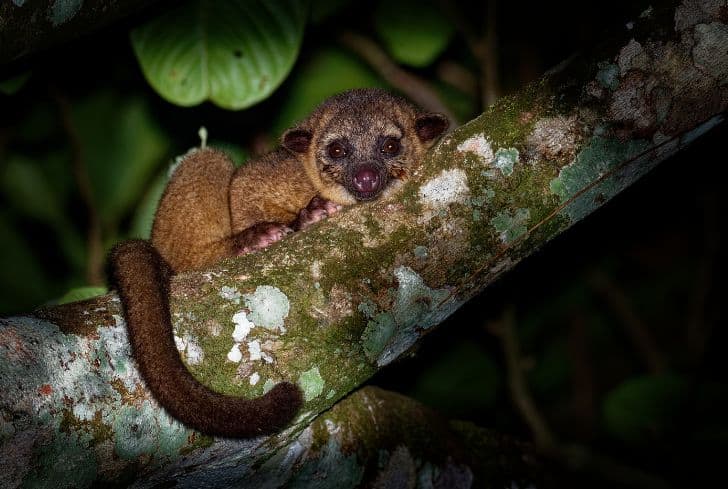
Cacomistles are small, agile mammals closely related to raccoons as they belong to the same Procyonidae family. Native to Central and South America, cacomistles prefer diverse habitats, including tropical forests and evergreen woodlands.
Because both animals are greyish and nearly the same size, you can mistake cacomistles with raccoons. They resemble each other, with cacomistles adorning the raccoons’ long, bushy ringed tails and the black facial mask.
Not only appearances, but cacomistles also share some of the raccoons’ behaviors. Although entirely arboreal, cacomistles are active at night like their cousins and do not prefer company. They also share similar diets; meat mainly from invertebrates, fruits, and nuts.
The main difference between the two animals is that while the cacomistles are entirely arboreal, raccoons sometimes can spend their days in hollow logs.
3. Red pandas

The nearly extinct red pandas are small adorable mammals that live in the rainy mountain forests of India, Bhutan, Nepal, central China, and Myanmar.
Red pandas were previously placed under the same family as the raccoons until recent research classified the cute creatures in their own family; Ailuridae.
That’s said, red pandas have a lot to share with raccoons, physically and behavioral. If you exclude the body color, red pandas look like raccoons. They’re the same size as their once relatives and boast long bushy tails. Red pandas also have a mask, although theirs is white. They have sharp retractable claws, which make the animals expert tree climbers like raccoons.
What’s more, red pandas are solitary and territorial creatures that mark their boundaries with urine. They’re also nocturnal, like raccoons.
But while both share the same diet, red pandas often munch on bamboo leaves and will only eat meat if an opportunity comes, unlike their distant cousins.
4. Badgers
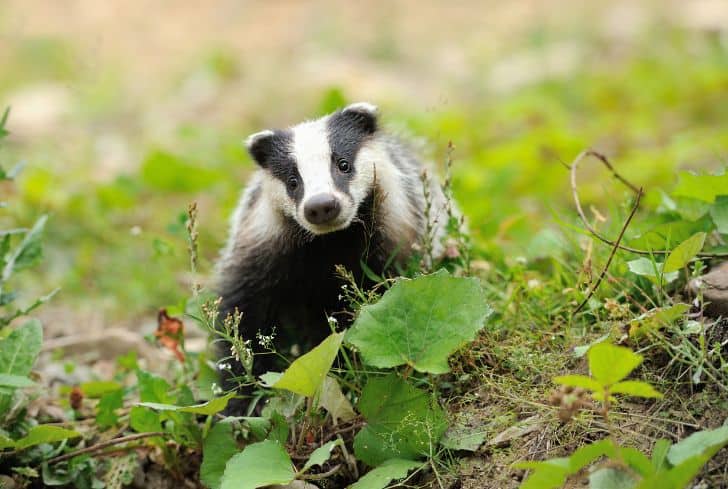
Badgers are small yet stocky mammals from the Mustelidae family living in various parts of the world.
Badgers might belong to a different family, but that doesn’t stop these aggressive creatures from having similarities with raccoons.
Like raccoons, all badgers are short-legged and have sharp claws for digging. Also, badgers have a taste of forest habitats, meadows, and urban areas, like raccoons, and prefer living in tunnels.
Both animals also exhibit behavioral similarities, with some species of badgers, such as wolverines choosing sem-social lives. Badgers also share raccoons’ omnivorous diet.
5. Olingos
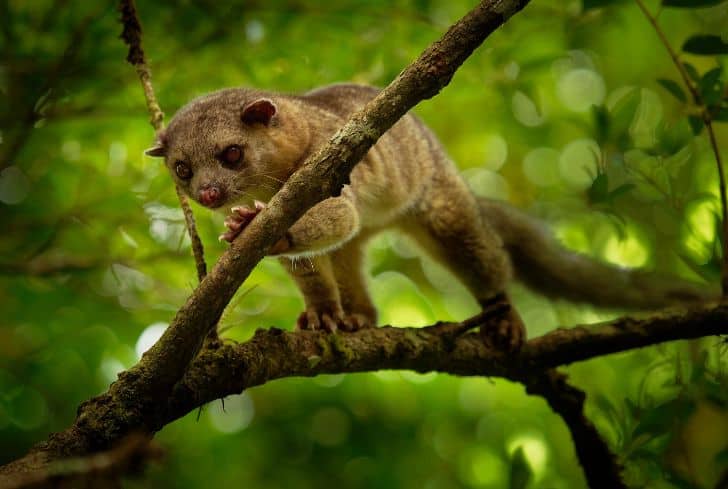
Olingos are small mammals from the Procyonidae family, which inhabit the jungles of South and Central America.
Since olingos come from the same family as raccoons, you can guess both animals share some characteristics.
Olingos have bodies built relatively the same as raccoons with the same pointed muzzles and round ears, and although they lack the facial mask, they have long, bushy tails with faint rings like their cousins.
Olingos are also omnivores, like their counterparts, although most of their diet comes from fruits.
Other behaviors olingos share with raccoons is preferring solitary lives, although sometimes you can find the former in climbing trees in pairs.
The main difference between the two is that olingos are entirely arboreal, and their bushy tails have only faint rings, unlike the raccoons.
6. Ringtailed cat
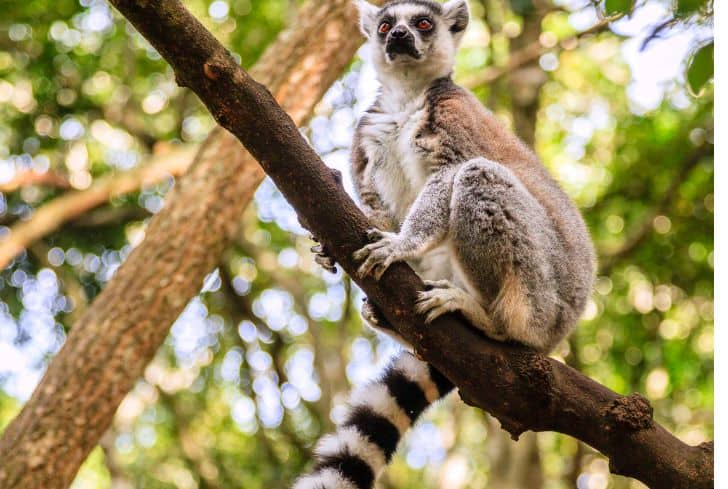
Ringtailed cats are small mammals and close relatives of raccoons that inhabit the dry and rocky regions of the Southernwesstern United States and Mexico.
Apart from the long Whiskers, ring tailed cats resemble raccoons in many ways.
The cats are built like raccoons with small rounded ears, pointed muzzles, and a black facial mask. They also have long distinctive bushy tails with rings all over that, alongside the sharp claws, make the animals expert tree climbers, like their cousins.
Both animals prefer the same foods and exhibit several similar behaviors, with the cats preferring to forage at night and sleep in dens during the day.
While you might confuse the two, if you’re keen, you can notice that ringtailed cats wear some Whiskers on their faces. The other difference is that the cats are entirely solitary creatures, and you can only find them in pairs during the breeding season.
7. Olinguitos
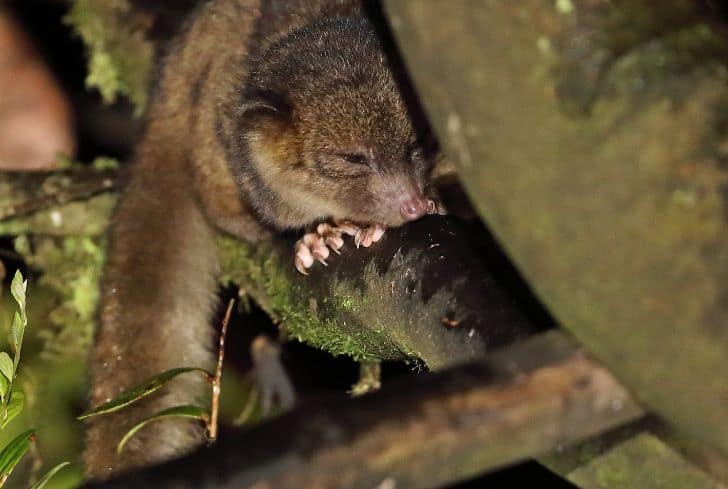
Belonging to a newly found genus, the olinguitos are the smallest members of the Procyonidae family. The small mammals predominantly live in the Andes mountain ranges of Ecuador and Colombia, where they prefer high canopies of tropical evergreen forests with high humidity and low cloud cover.
Like other procyonids on our list, olinguitos are similar to raccoons in several respects.
Body-wise, olinguitos are built the same way as raccoons, as they also have long fingers with small but sharp claws to allow great dexterity like their relatives. Plus, they have long, bushy ringed tails that make these small mammals adept tree climbers like their bigger cousins.
Appearances aside, both animals exhibit some behavioral similarities, with olinguitos preferring an omnivorous diet and foraging at night.
The main difference is olinguitos, although smaller than raccoons, have large eyes and are solitary animals.
8. Kinkajous
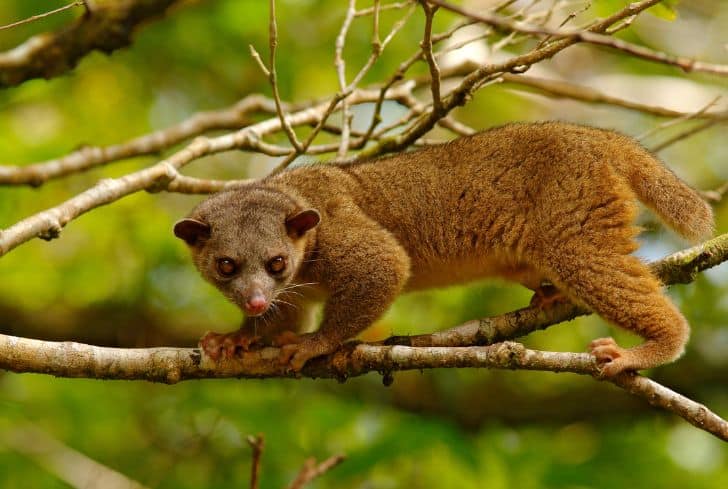
Kinkajous are small mammals that live in tropical rainforests in Central and South America. They look like primates but are procyonids, closely related to the red panda.
Like raccoons, kinkajous boast five toes with sharp claws, which, although not as skillful as their cousins, help the animals climb from tree to tree effortlessly. Also, kinkajous have long bushy tails to complete the list of the main physical similarities with raccoons.
Behavior-wise, kinkajous are nocturnal creatures like their relatives and also omnivores.
But unlike raccoons who only socialize when feeding and mating, kinkajous are highly social creatures that can meet for various purposes such as grooming each other.
The other notable difference is kinkajous are smaller than their cousins and lack rings on their tails.
9. Raccoon dogs
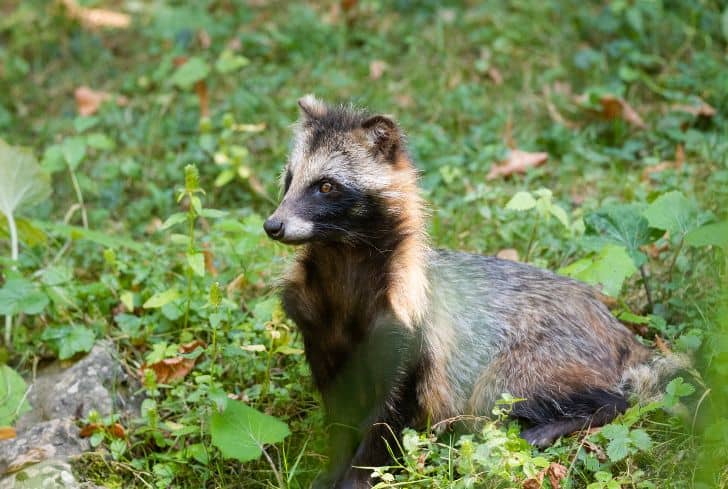
Also called Japanese dogs, raccoon dogs are small mammals from the Canidae family. These dogs are native to Southeastern China, Japan, and Korea.
While raccoon dogs belong to a different family and may have fox-like appearances, that doesn’t stop them from sharing several characteristics with the common raccoons.
Both animals share robust bodies, mask-like hairs around the face, small heads, and small eyes.
Furthermore, Japanese dogs, like their namesakes, boast of dexterous front paws that help the animals climb trees effortlessly and hold slippery prey. Also, both animals share the same type of food.
The main difference between the two is the Japanese dogs are more heavily built but smaller in size than the common raccoons. Also, the dogs prefer a social life, unlike their counterparts.
10. Wolverines

About the size of a medium dog, wolverines are the largest land-dwelling members of the family Mustelidae. They live in isolation in the arctic, boreal, and alpine areas of Alaska, Siberia, Northern Canada, and Fennoscandia.
Although wolverines have dark oily fur and elongated bodies, the animals are still similar to raccoons in some respects.
They all have small eyes, short, rounded ears on their tiny heads, and five dexterous front toes, which make wolverines expert tree climbers.
However, although both animals are territorial, wolverines are more aggressive and are known for their reputation for confronting large animals such as hyenas.
They’re also slightly longer than raccoons.
11. Ferrets
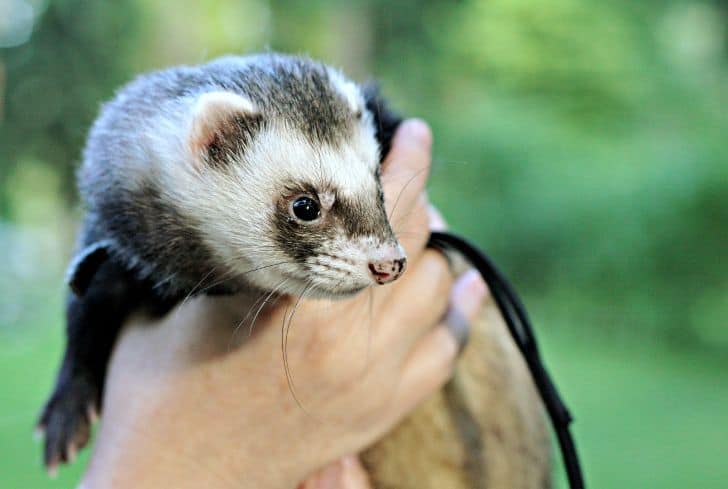
Growing to about 50 centimeters, ferrets are small domesticated species from the Mustelidae family.
Ferrets may not share many physical characteristics with the raccoons like most animals on our list.
That said, these domesticated mammals are considered similar to raccoons as they have five dexterous toes, tiny heads, and small rounded ears. They also have bushy tails, although they lack rings.
Some varieties of ferrets have brown fur, meaning you can mistake them for raccoons if it were not for their elongated bodies.
12. North American River Otter
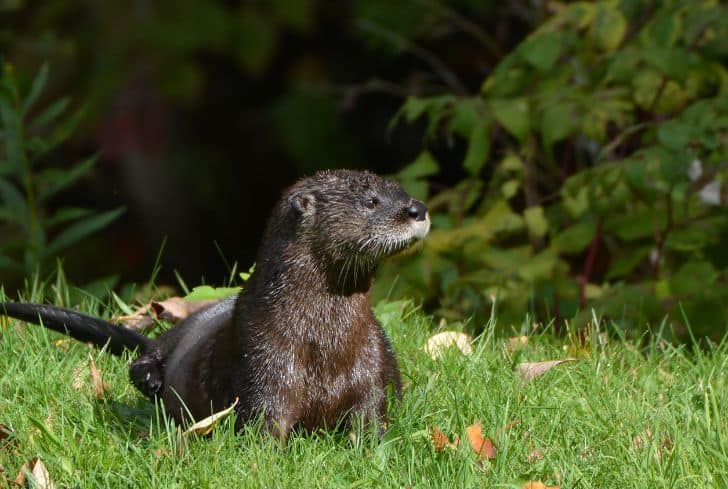
North American River Otter is a small semi-aquatic mammal found near coasts and waterways in the North American continent.
Although these otters are elongated, they’re still stout and have five toes on their front legs like raccoons.
Other similar physical characteristics include long tails and small rounded ears.
However, the elongated necks and slender bodies of North American otters make identifying the two animals an easy task.
The other difference is you can only find otters near water bodies, unlike their counterparts.
13. Weasels

Weasels are small active predators from the Mustelidae family, found in various parts of the world, including Africa, America, and Eurasia.
According to DNA evidence, weasels are close relatives of raccoons. That probably explains why the Weasels are adaptable to live in various habitats, including wooded areas, open fields, roadsides, and farmlands, like their distant cousins. Both animals share some physical characteristics, including small heads, tiny rounded ears, and dexterous toes for climbing trees.
However, weasels stand out with their slender bodies and elongated necks. They are also voracious hunters as they need about half a percent of their body weight of prey a day.
14. Stoats

Stoats are small mustelids native to Eurasia and parts of North America.
Apart from short, rounded ears, and long tails, stoats do not share a lot with raccoons in terms of physical appearances.
They, however, exhibit some behavioral characteristics associated with the raccoons, such as marking their territories, and will also confront any intruders. Both animals also live in tunnels, although stoats do not put effort into making them, unlike the raccoons.
But although similar in some respects, the difference between stoats and raccoons is apparent. The former have slender bodies with elongated necks.
15. Sun bears

The sun bear is the smallest bear, native to Southeast Asia, where it inhabits tropical forests.
The last animal on our list has the fewest similarities with the raccoons.
Although you can tell the difference with little effort thanks to the bear’s black fur and big size, the arboreal animal bear some physical resemblance to the raccoons with their small muzzles and small rounded ears. Sun bears are also stout and are adapted to climbing trees.
What’s more, sun bears are omnivores to complete their few similarities with the raccoons.


![Hyena vs Coyote [Differences & Strength Comparison]](https://eartheclipse.com/wp-content/uploads/2022/08/Hyena-vs-coyote.jpg)
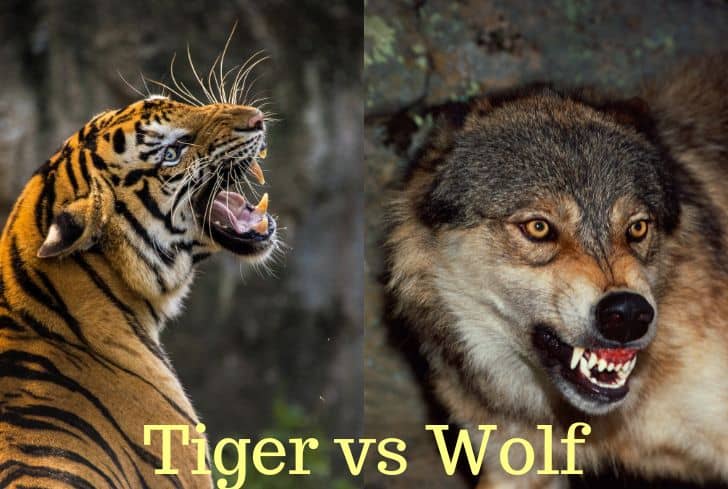
![Hyena vs Wolf [Differences & Strength Comparison]](https://eartheclipse.com/wp-content/uploads/2022/08/Hyena-vs-Wolf.jpg)
![Coyote vs Wolf [Differences & Strength Comparison]](https://eartheclipse.com/wp-content/uploads/2022/08/Coyote-vs-wolf.jpg)
